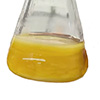| Oct 02, 2025 |
The structural properties in the mycelium of a common soil mold show promise in biomedical applications, such as hydrogels and tissue scaffolding.
|
|
(Nanowerk News) Fungi are vital to natural ecosystems by breaking down dead organic material and cycling it back into the environment as nutrients. But new research from the University of Utah finds one species, Marquandomyces marquandii, a ubiquitous soil mold, shows promise as a potential building block for new biomedical materials.
|
|
In recent years, scientists have examined fungal mycelium, the network of root-like threads—or hyphae—that penetrate soils, wood and other nutrient-bearing substrate, in search of materials with structural properties that could be useful for human purposes, particularly construction.
|
|
In a series of lab demonstrations, U mechanical engineering and biology researchers show M. marquandii can grow into hydrogels, materials that hold lots of water and mimic the softness and flexibility of human tissues, according to a recent study (JOM, “Multilayer, Functionally Graded Organic Living Hydrogels Built by Pure Mycelium”).
|
|
Unlike other fungi that struggle with water retention and durability, M. marquandii produces thick, multilayered hydrogels that can absorb up to 83% water and bounce back after being stretched or stressed, according to Atul Agrawal, the lead author of the study and a Ph.D. candidate at the John and Marcia Price College of Engineering. These properties make it a good candidate for biomedical uses such as tissue regeneration, scaffolds for growing cells or even flexible, wearable devices.
|
|
His paper is the latest to emerge from the lab of senior author Steven Naleway, an associate professor of mechanical engineering. In collaboration with mycologist Bryn Dentinger, a curator at the Natural History Museum of Utah, he explores biological substances to develop bioinspired materials with structural and medical applications.
|
|
Agrawal and Naleway are seeking patent protection for their discoveries about the Marquandomyces fungus.
|
|
“This one in particular was able to grow these big, beefy mycelial layers, which is what we are interested in. Mycelium is made primarily out of chitin, which is similar to what’s in seashells and insect exoskeletons. It’s biocompatible, but also it’s this highly spongy tissue,” said Naleway, whose lab is funded by the National Science Foundation. “In theory, you could use it as a template for biomedical applications or you could try to mineralize it and create a bone scaffolding.”
|
|
Fungi comprise its own kingdom of organisms, with an estimated 2.2 to 3.8 million species, and just 4% have been characterized by scientists. For decades, scientists have derived from fungi numerous pharmacological substances, from penicillin to LSD. Naleway is among a cohort of engineers now looking to fungal microstructures for potential use in other arenas.
|
|
The way fungal hyphae grow is the reason why mycelia could have useful structural properties.
|
|
“As they grow forward, they lay down these cross walls that then compartmentalize a really long filament into many, many individual cells,” said Dentinger, an associate professor of biology and a curator at the Natural History Museum of Utah. “They will grow as long as there’s enough nutrition around. There’s not a developmental stage where they’ll stop. That’s a fundamentally different strategy to living in the environment than animals have achieved.”
|
|
Fungi evolved multicellularity in ways that are much different than what we see in animals and plants, in which cells differentiate and usually remain in differentiated states.
|
|
“In fungi, every cell is capable of differentiating and then reverting to the original state. They’re just a lot more malleable and adaptable,” Dentinger said. “So there’s a lot that we could exploit from those behaviors that really haven’t been explored fully.”
|
|
Over the course of the study, the team found these mycelial cultures showed an unusually high degree of hydrophilia, retaining 83% water without losing its shape.
|
|
“What was interesting about our research was that the fungus itself created a full-blown structure that was highly organized,” Agrawal said. The Marquandomyces outperformed materials made from more commonly studied fungi, such as Ganoderma and Pleurotus, species that exhibit limitations in water retention, restricting their application in hydrogel-based biomedical systems.
|
|
In lab experiments, Agrawal’s team found the material could recover 93% of its shape and strength after repeated stress.
|
|
“For it to be able to hold this structure together, this entire mycelium colony is connected together, and what we saw through optical imaging is that within these layers at the site of transition, it’s a functionally graded structure,” Agrawal said. “It helps distribute the stress concentration between layers. So when we apply mechanical stress, it distributes that stress evenly and helps with the mechanical performance of these hydrogels.”
|

